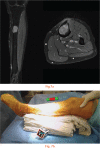Augmented reality in bone tumour resection: An experimental study
- PMID: 28258117
- PMCID: PMC5376655
- DOI: 10.1302/2046-3758.63.BJR-2016-0289.R1
Augmented reality in bone tumour resection: An experimental study
Abstract
Objectives: We evaluated the accuracy of augmented reality (AR)-based navigation assistance through simulation of bone tumours in a pig femur model.
Methods: We developed an AR-based navigation system for bone tumour resection, which could be used on a tablet PC. To simulate a bone tumour in the pig femur, a cortical window was made in the diaphysis and bone cement was inserted. A total of 133 pig femurs were used and tumour resection was simulated with AR-assisted resection (164 resection in 82 femurs, half by an orthropaedic oncology expert and half by an orthopaedic resident) and resection with the conventional method (82 resection in 41 femurs). In the conventional group, resection was performed after measuring the distance from the edge of the condyle to the expected resection margin with a ruler as per routine clinical practice.
Results: The mean error of 164 resections in 82 femurs in the AR group was 1.71 mm (0 to 6). The mean error of 82 resections in 41 femurs in the conventional resection group was 2.64 mm (0 to 11) (p < 0.05, one-way analysis of variance). The probabilities of a surgeon obtaining a 10 mm surgical margin with a 3 mm tolerance were 90.2% in AR-assisted resections, and 70.7% in conventional resections.
Conclusion: We demonstrated that the accuracy of tumour resection was satisfactory with the help of the AR navigation system, with the tumour shown as a virtual template. In addition, this concept made the navigation system simple and available without additional cost or time.Cite this article: H. S. Cho, Y. K. Park, S. Gupta, C. Yoon, I. Han, H-S. Kim, H. Choi, J. Hong. Augmented reality in bone tumour resection: An experimental study. Bone Joint Res 2017;6:137-143.
Keywords: Augmented reality; Bone tumour; Navigation.
© 2017 Cho et al.
Conflict of interest statement
Figures







References
-
- Young PS, Bell SW, Mahendra A. The evolving role of computer-assisted navigation in musculoskeletal oncology. Bone Joint J 2015;97-B:258-264. - PubMed
-
- Cho HS, Park YK, Han I, Kim H-S, O’Donnell RJ. Augmented-Reality Assistance in Bone Tumor Surgery [abstract]. ISOLS meeting, 2015.
-
- Zhang Z. A flexible new technique for camera calibration. IEEE Trans Pattern Anal Mach Intell 2000;22:1330-1334.
LinkOut - more resources
Full Text Sources
Other Literature Sources
Research Materials

